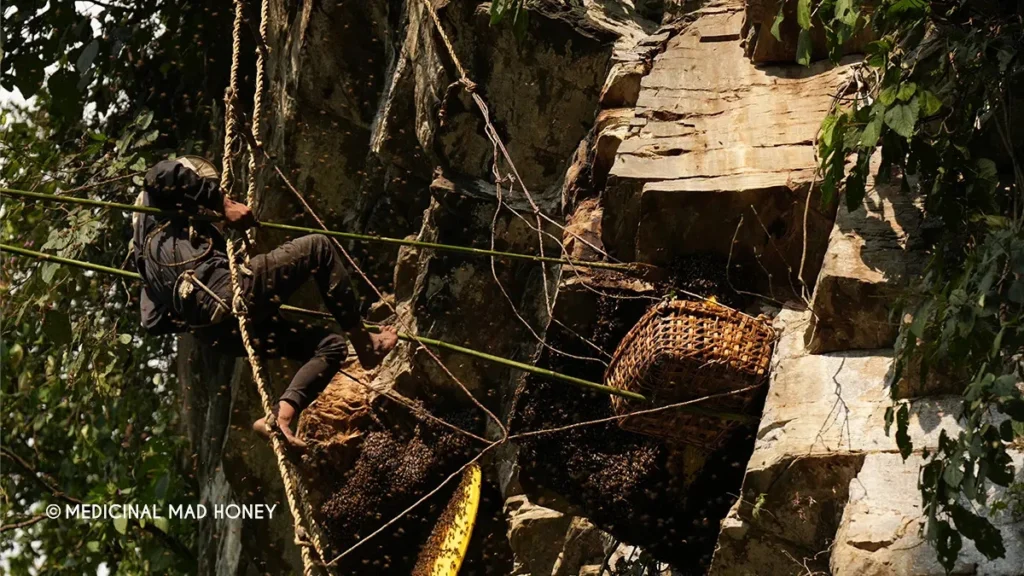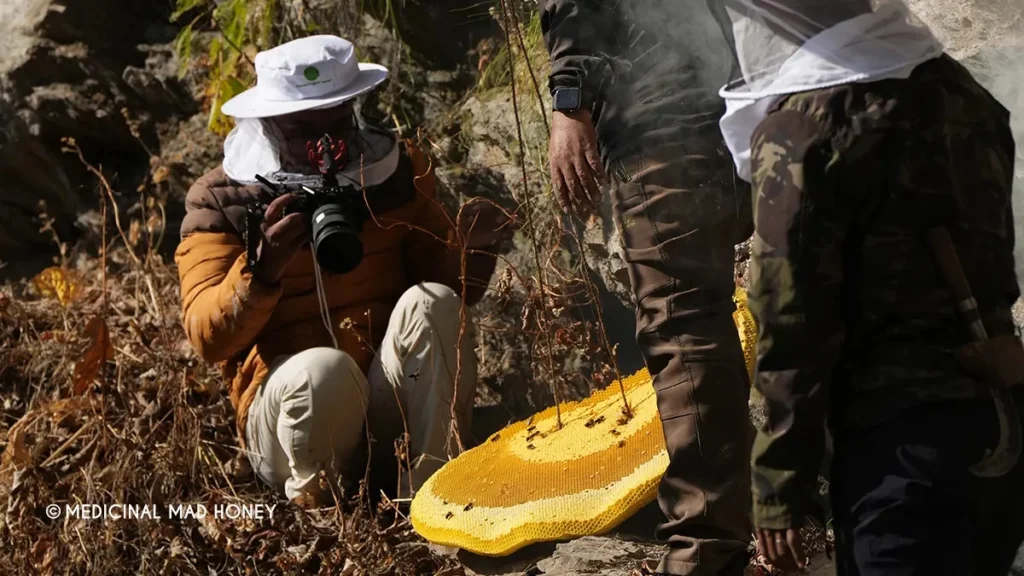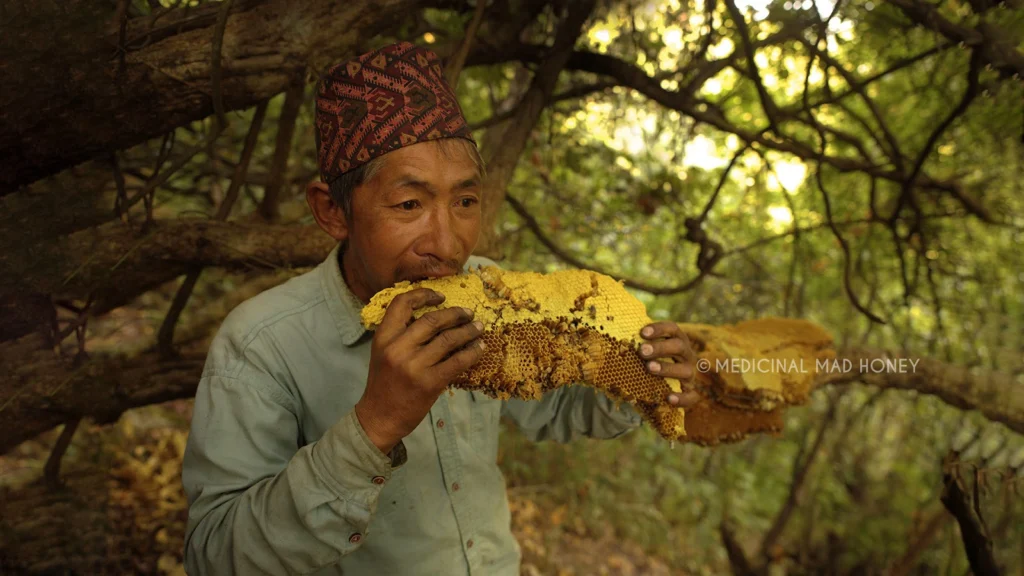Gurungs and the medicinal use of Mad Honey
Gurungs, among other 142 ethnic groups of Nepal reside mostly in the Himalayan foothills and upper hilly regions. The name Mad Honey is linked to this community- they were the ones to first see it, hunt it down, taste it and use it further in their lifestyle.
This community has been continuously harvesting honey to date, and as of today, the mad honey has transformed their lives. What began as just a food source with medicinal benefits has now become a significant means of financial gain, especially after the worldwide attention it gained following 2014/2015.
What is Mad Honey?
Mad honey is just another honey type-a sweet, sugary edible substance produced by bees. The only difference that adds “Mad” suffix to it is the presence of an extra psychoactive compound (grayanotoxin) in it, which is naturally present in flowers the bees visit.
Although the edible property matches normal honey, the creation of mad honey is limited to a different kind of bee! They don’t buzz around-(you heard it right!)- they are native to higher altitudes. Termed as Himalayan Giant bees (Apis laboriosa), these bees are 2-3 times bigger than the normal honey bee and serve as the main pollinators of the region.
As we have introduced you to a different type of honey bee, another peculiar thing about mad honey is the type of flowers involved in the process. These giant bees are compelled to forage on flowers of Rhododendrons and some other wildflowers for nectar collection as there are not many flowering plants in the himalayan region. Although these plants are also found in lower regions of Nepal, the Grayanotoxin content in the flowers in these regions are higher compared to the lower regions.

Gurung People and Mad Honey Discovery
Gurung people are indigenous inhabitants of the mid-hills, covering up around 2% of the total population of Nepal. Though less in proportion, these people have a significant role in the discovery of mad honey.
Living in the remote corners of Nepal, they were the ones who first encountered the honeycombs hanging from the cliffs. With a sense of curiosity, they removed its chunks and sampled a little bit of it-just to know that another food source was found.
Traditional Harvesting
With the arrival of spring and autumn, the preparation for honey hunt begins. A person from the community who has the strength and endurance to climb up the cliff and face the huge number of giant bees is selected as a potential lead for the collection.

The group of hunters who have been practising this ancient tradition of honey harvesting travels to the hunting site. One of the elders or the shaman who has enough knowledge starts the prayer by making offerings to the spirit of cliff gods, Rangkemi, for the safety of the hunter.
The rope is laid down, smoke is prepared and the honey hunter descends from a cliff as high as the sky. The honey hunter with baby steps carefully descends as a miss of step can cost life. Surrounded by hundreds of these giant bees and their painful stings the honey hunter carefully and sustainably cut the honeycomb using traditional equipment. The honeycomb is then dragged down using bamboo from which the mad honey is extracted.
Traditional use by the Gurungs
When newly discovered, mad honey was used only inside the community due to limited harvesting. The wax obtained from harvest was only traded in the nearby markets with exchange for food and money. It was then the wax was popular as a natural glaze for dishes.
The Mad Honey later got popular as a superfood and recreational food and Gurungs later discovered they can make a good earning by the sale of this product. However the use of this honey has evolved into various forms over time, within the Gurung community.
- Mad honey with high potency of Grayanotoxins harvested from higher altitudes during the spring season, was used to prepare local fermented beverages known as Mead for the unique effects and experience.
- Mad honey, harvested during the autumn season, was cooked and further processed into candies that kids used to enjoy.
- Mad Honey was used as an active ingredient for the tobacco mix, which enhanced the flavor of the tobacco and supposedly made them feel relaxed.
- Mad honey was consumed during special occasions and was also used as a souvenir in the Gurung culture; it was a gift for their guests and visitors.
Therapeutic use of Mad Honey by Gurungs
Mad honey was not only a part of the celebration, it was also a sacred medicine for Gurungs, it still is. For their survival, they transported heavy loads of wood from forests (on their back!) and also supplies from the city nearby. The physically demanding lifestyle inevitably caused body pain and as they grew older, arthritis-related symptoms like joint pain became obvious. This is when mad honey worked as a miracle-a gulp of it and the next day, all their pain would fade away.

Digestive issues: Another popular use covers the use of Mad Honey for healing stomach troubles and issues. Whenever there was a burning sensation of the Gastritis or nausea or indigestion the Gurungs gave a spoon of this golden remedy.
Vitality: They even consumed Mad Honey before heavy physical workout as the Mad Honey gave them consistent energy during work and after to reduce and numb the pain. Mad Honey really was used as an analgesic to treat pain as a home remedy.
Home Remedies: The Gurungs far from Modern world and pharmaceutical medicine used this mad honey for treating inflammations and for wound healing. They even applied it in fractures and said it helped them heal quicker. Also, mad honey was used to treat coughs, colds and respiratory issues.
Modern Day Use- Economic Evolution
Mad honey has growing international curiosity, and the ones most benefited are Gurungs. From the time when they didn’t even get a dollar for selling a whole hive to this time where their entire livelihood has been funded and fueled by mad honey.
- Mad Honey as an income source : A high value of Mad Honey on the international market has provided enough economic independence to the Gurungs. It has been a better source of income than hard labor and foreign employment
- Tourism and Eco-Experience Economy: With the international market showing growing interest in the Mad Honey, a large number of tourists each year are travelling to see it with their own eyes. The harvesting seasons are hence another source of income for them making Gurung village a tourist hub and economic ground.
Conclusion
Mad honey, once a cultural artifact in the Gurung community, has really been a stroke of luck and favor in the present time. The first ones to know about the mad honey and the ones to pass their sacred harvesting knowledge to future generations are maintaining the legacy of honey hunters. The skill and knowledge of honey hunting passed down from ancestors are providing new generations with an opportunity of financial liberation. Overall, the journey feels like a silent blessing from Rakumeng – the cliff god they trust deeply, as they rise with faith and risk it all.














